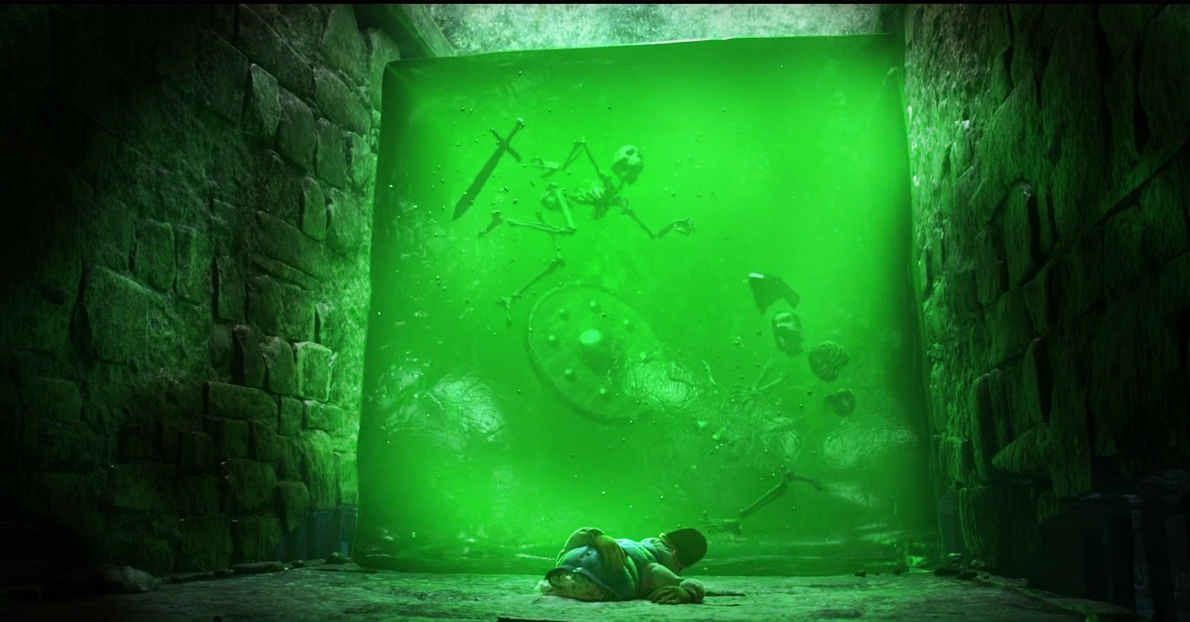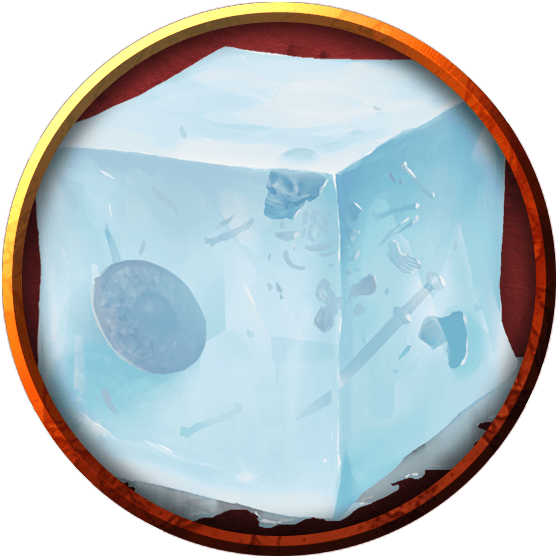A 10-foot high transparent ooze in the shape of a cube. Bits of debris float in its gelatinous body.
A gelatinous cube, also known as an athcoid, was a transparent ooze composed of mindless, gelatinous matter in the shape of a cube or rhombohedron. They were especially favored by the drow god Ghaunadaur.
“The dungeon's floors were spotless. That should have been our first clue.”
— Jaster Hollowquill, on his exploration of Undermountain.
Gelatinous cubes scour dungeon passages in silent, predictable patterns, leaving perfectly clean paths in their wake. They consume living tissue while leaving bones and other materials undissolved.
A gelatinous cube is all but transparent, making it hard to spot until it attacks. A cube that is well fed can be easier to spot, since its victims' bones, coins, and other objects can be seen suspended inside the creature.
Oozes. Oozes thrive in the dark, shunning areas of bright light and extreme temperatures. They flow through the damp underground, feeding on any creature or object that can be dissolved, slinking along the ground, dripping from walls and ceilings, spreading across the edges of underground pools, and squeezing through cracks.
The first warning an adventurer receives of an ooze's presence is often the searing pain of its acidic touch. Oozes are drawn to movement and warmth. Organic material nourishes them, and when prey is scarce they feed on grime, fungus, and offal. Veteran explorers know that an immaculately clean passageway is a likely sign that an ooze lairs nearby.
Slow Death. An ooze kills its prey slowly. Some varieties, such as black puddings and gelatinous cubes, engulf creatures to prevent escape. The only upside of this torturous death is that a victim's comrades can come to the rescue before it is too late.
Since not every ooze digests every type of substance, some have coins,
Metal gear, bones, and other debris suspended within their quivering bodies. A slain ooze can be a rich source of treasure for its killers.
Whether this is true or not, the Faceless Lord is one of the few beings that can control oozes and imbue them with a modicum of intelligence. Most of the time, oozes have no sense of tactics or self-preservation. They are direct and predictable, attacking and eating without cunning. Under the control of Juiblex, they exhibit glimmers of sentience and malevolent intent.
Unwitting Servants. Although an ooze lacks the intelligence to ally itself with other creatures, others that understand an ooze's need to feed might lure it into a location where it can be of use to them. Clever monsters keep oozes around to defend passageways or consume refuse. Likewise, an ooze can be enticed into a pit trap, where its captors feed it often enough to prevent it from coming after them. Crafty creatures place torches and flaming braziers in strategic areas to dissuade an ooze from leaving a particular tunnel or room.
Spawn of Juiblex. According to the Demonomicon of Iggwilv and other sources, oozes are scattered fragments or offspring of the demon lord Juiblex.
Ooze Nature. An ooze doesn't require sleep.
The Menagerie fought one in the ruins under the Outding Refuge Church. Later they found 4 hiding a trap made by Jacoby.
Description
Typically, a gelatinous cube measured between 10 to 15 feet (3 to 4.6 meters) on a side and weighed as much as 50,000 pounds (23,000 kilograms), although legends existed of much larger cubes. The creature was completely transparent, with only a glint of its surface in the light to give away its position. The occasional random object floating in a well fed gelatinous cube's body could also serve as a warning of its presence to dungeon delvers.
Gelatinous cube bodies were remarkably moldable. They could flow around objects and through narrow passages, quickly returning to their shapes once enough space was available.
Reproduction
Gelatinous cubes reproduced asexually by either dividing themselves into two smaller cubes of equal sizes or via budding. In the second case, a smaller, rubbery cube was excreted into a side corridor or on a pile of refuse, and left to fend for itself until it grew into a full-sized cube. These smaller cubes were not cared for and ran the risk of being absorbed by their own parents on their next trip down the corridor. Surviving young cubes then rapidly grew to adult sizes.
When two gelatinous cubes met, they could temporarily fuse into a larger form that acted like a single creature. They could remain in that fused form for up to a few days before splitting and going their separate ways.
But that’s not the only time the cubes will split, about every 6 years a cube will split into two ‘baby’ cubes that are slightly smaller, about 8-feet on each side, and they will fully grow into a 10-foot cube after 3 months. Interestingly the Gelatinous Cube is also called an immortal creature, as nothing short of starvation or death by adventurers can end its existence. So after the apocalypse, there will be only roaches, twinkies, and Gelatinous Cubes. We call dibs on the twinkies and roaches.
Habitats
These creatures were typically found inhabiting underground locations or dungeons. They were more common in heavily frequented dungeons, attracted by the more readily available food and carrion.
Environment: Underdark
Diet
Gelatinous cubes were omnivorous scavengers.
Despite being extremely effective against flesh and cellulose, the digestive fluid of gelatinous cubes had no effect on inorganic matter or bones. Any inorganic matter would remain within their bodies for several weeks until eventually being cast out.
Behavior
A gelatinous cube was a mindless predator that silently roamed ancient crypts and vaults in regular, predictable patterns. As they traveled the halls of old ruins, they absorbed any material in their paths from the floors and walls. Although incapable of climbing walls, particularly large gelatinous cubes could also absorb mold and moss from ceilings. Organic material was quickly dissolved in the acidic ooze that made up the cube's body, while bones and inorganic matter spent some time floating within the creature until eventually expelled. As they slid through the corridors, they left behind a perfectly clean path, except for an occasional slimy trail.
Combat
When facing an opponent, a gelatinous cube could slam it with an acidic pseudopod or attempt to engulf it. It was possible, although difficult, for sufficiently strong creatures to escape engulfment by a gelatinous cube. Despite their slow speed, gelatinous cubes were strong and could easily push back and knock over even large creatures.
When touching a creature, gelatinous cubes secreted a gummy paralyzing substance that was immediately absorbed through the skin into the victim's bloodstream. After successfully engulfing a victim, the cube moved pockets of an acidic digestive substance towards the victim's body, quickly digesting it. Survivors of gelatinous cube attacks displayed scars that resembled partially melted wax.
Regardless of their sizes and homogeneous composition, gelatinous cubes were vulnerable to most usual forms of attack, although reports existed of cubes that were immune to electricity. Mind-altering effects were useless against the mindless creatures. Some were said to be slowed down by cold-based spells.
This kind of creature does not normally carry treasure, but it may contain some coins and trinkets not yet dissolved. This kind of creature does not normally have or collect treasure. However, the creature may have a lair full of bodies, or reside somewhere that treasure already exists.
This creature produces no Harvested Meat as it is made of animated ooze.
 Intellect Devourer
Intellect Devourer


